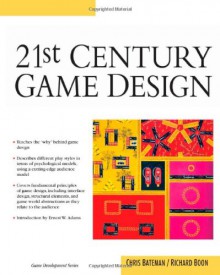21st Century Game Design is not just a book about game design. It's an answer to two important questions: who are we designing games for and how do we do it best? Written by industry pros, the book teaches designers how to design better games from a why perspective. All good designers know the...
show more
21st Century Game Design is not just a book about game design. It's an answer to two important questions: who are we designing games for and how do we do it best? Written by industry pros, the book teaches designers how to design better games from a why perspective. All good designers know the fundamentals of how to design a game, but learning to design games that really satisfy your players takes more than technical skill. To do this successfully, you need to know your intended audience and understand their needs. Throughout the book you'll learn about defining and investigating player needs. A model of play styles is then presented that was developed by applying psychological metrics to survey data and case studies. This model identifi es some of the core themes in player needs as represented by four player types-- Conqueror, Manager, Wanderer, and Participant. In addition to discussing player needs, the book also explores how games can reach wider audiences by appealing to the interests of the core gaming community, and it considers the fundamental principles of game design. Methods such as interface design, structural elements, and game world abstractions are discussed in relation to the needs of the audience. The book does not attempt to present an absolute view of the craft of game design, but rather it demonstrates how an audience model can inform the design process and take the games industry forward at a time when it is facing a schism between the games that the audience would like to play, and the games the development community would like to make. Game designers, producers, marketing executives, and anyone who wishes to understand the relationship between a game and its audience will find much to learn from 21st Century Game Design. Author's Reflections Six Years On... It's been six years since Richard Boon and I wrote 21st Century Game Design, and since then many of the claims we made which once were revolutionary are now commonplace. The idea that commercial game design requires models that help developers understand how and why people play games was still quite revolutionary in 2005. Richard Bartle's work had pointed in the general direction almost ten years earlier, but had been constrained to massively multiplayer games, and was more qualitative and less quantitative than the research described in this book. The biggest sign of the success of our approach was the IEEE's creation of a Player Satisfaction Modelling Task Force in 2009, which I was appointed too in recognition for my work helping to establish the domain. Since then, I've been amazed at some of the incredible work that's been going on in player satisfaction, and happy to have contributed to the field's growth and development. There are far more up-to-date player satisfaction models than the DGD1 described in this book, but there is still no better introduction to the idea of using player models to guide game design than 21st Century Game Design. What's more, the work Richard did in constructing a historical snapshot of game design in the context of this model gives a remarkable account of the development of videogames, one with a lot to teach about how games have been made, and how they could be made in the future. But despite the most groundbreaking aspect of this book being its presentation of player satisfaction modelling--even before this term came into use!--what I look back upon most fondly in this title is our perspective on game design. The chapter on Foundations of Game Design remains an excellent introduction to the issues in practical game design and development (although we don't much use the terminology in this chapter any more) and the recognition of abstraction as part of the process of design remains relevant today. There is a set of chapters here that will help any new game designer understand what it is they are trying to do, while an experienced game designer will find a lot to agree with, and some new ways of thinking about old problems. The discussion of Game Structures (Chapter 10) is as relevant today as it was when we wrote it--and terms like "playground worlds," "Breadcrumbing," and "Funnelling" have since been used by a great variety of game designers and game writers. It's satisfying to see our work being used by other people to help them make games. If you are new to game design, 21st Century Game Design is an excellent primer in the practical aspects of commercial videogame design, and if you have more experience you'll find ideas in here that might expand your perspective on the discipline. There are a lot of great books on game design, but none are quite like this one. Chris Bateman April 2011
show less

